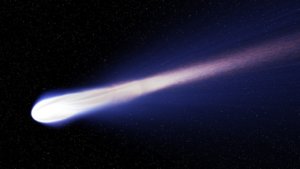
by Dr Manjir Samanta-Laughton | Jun 10, 2020 | Paradigm Revolution, Punk Science, Science
We are used to comets having long tails but recent investigations show us that comets give off fine jets, but why?
The Old Picture of Comets
We tend to think of comets as snowballs in the sky with long tails.
Ancient people used to think that they were signifiers of doom.
But it’s only in recent years that we have been able to study them in more detail because the European Space Agency has sent probes to various comets.
New Surprises
And what they found was a big surprise.
Instead of just one long tail as the comet nears the sun, comets actually give off jets of vapour and dust including water vapour.
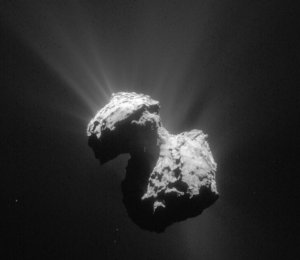
ESA/Rosetta/NAVCAM – CC BY-SA IGO 3.0
These can also be accompanied by an increase in brightness.
The video above contains another image of a comet with jets spinning through space.
Too much power
At first, people thought that these plumes must be caused by the sun which heats up ice and gases beneath the surface.
But these plumes erupt with so much power that there must be another energy source involved.
Black holes and comets
Of course from the perspective of The Black Hole Principle, we would expect comets to give off jets intermittently including water vapour.
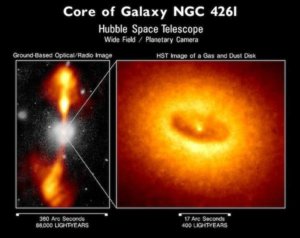
That’s because the same process is happening at different scales from a galactic black hole to even a comet.
Just as black holes give off intermittent jets, so do comets.
I hope you have enjoyed this episode of Punk Science TV.
Please leave a comment below with your thoughts about comets, jets and black holes.

by Dr Manjir Samanta-Laughton | May 27, 2020 | Punk Science, Science
Conventional Scientists believe that black holes burp on their food! In this episode of Punk Science TV, we explore this concept.
A Ridiculous idea
Scientists tend to think of people like myself as spouting a load of New Age spiritual nonsense. In some cases such as when the word ‘ quantum’ is bandied about amongst healers with no real mind to its actual context in physics, these accusations may have a case.
However, there are times, when mainstream scientists are the ones who come across as ridiculous. So in this example, we are discussing the concept of burping black holes.
The wrong monster
As you may know, the prevailing concept amongst mainstream scientists is that black holes are these great devouring monsters that tear apart stars and anything else that comes too close.
However, once the actual evidence began appearing, it became clear that black holes are visible because they are so bright and that also give off a lot of energy and material.
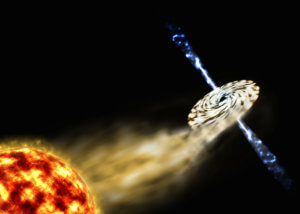
Old Picture of Black Holes, Shutterstock
Burp after the feast
Unable to give up their long-cherished notions that black holes are destructive monsters, these jets that are being emitted from black holes are then turned into ‘burps’.
The idea is that the black hole has feasted and then burps on its food.
This is lazy science.
The Projection game
Rather than realise that their concepts and theories do not match the evidence, they invent ‘burping’ black holes. Human characteristics are being projected onto objects in space as a way of coping with behaviour we don’t understand.
We understand that humans sometimes burp after eating a big meal so we have projected that onto black holes in order to avoid the thorny issue that, according to their own theories, nothing should escape a black hole.
Jets are predicted by The Black Hole Principle
Intermittent jets streaming from black holes are exactly what we would expect in The Black Hole Principle which says that black holes are creative.
We do not need to project any nonsensical ideas onto black holes if we understand that they are just a natural part of the universe unfolding.
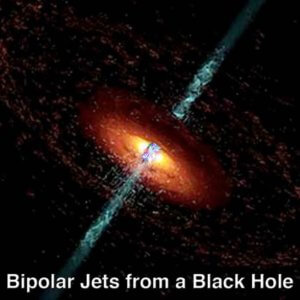

by Dr Manjir Samanta-Laughton | Apr 15, 2020 | Punk Science, Science
Five things you probably didn’t know about the Moon
Here are five mind-blowing facts you may not have realised about our closest neighbour
1. The Moon is flashing at us and we don’t know why
For many years now we have seen flashes on the Moon. They last between a few minutes to hours and we can’t predict them.
They have been spotted by amateur astronomers as well. Interestingly they do not seem to leave traces behind on the surface of the Moon.
Some speculate that these flashes could be associated with seismic activity but astronomers do not really know what they are.
Explanation: these flashes are created because the Moon also displays Black Hole Principle behaviour in that sometimes it creates light through the annihilation process of matter and antimatter.

The Black Hole Principle
2. A very dense anomaly has been detected under the South Pole of the moon.
As our ability to analyse bodies in space become more sophisticated, we have been able to scan the moon more deeply and found a few surprises. This has led to the finding of a very dense anomaly at the South Pole of the Moon. It could be some kind of very heavy metal and it’s 300 km beneath the surface. Our sense of the consistency of the moon has had to change.
Explanation: As discussed in previous articles on this site, it seems that many elements are generated by The Black Hole Principle, possibly all the elements. So this could be the reason why there is a dense anomaly 300 km beneath the surface of the Moon. It is being created by the centre of the Moon.
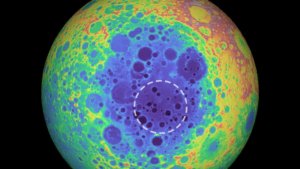
Image: © NASA/Goddard Space Flight Center/University of Arizona
3. The Moon contains water ice and could be producing it.
We used to think that the Moon was dry but now we know there is a lot of water there. It is especially around the poles and in craters as water ice.
Explanation: Water production is one of the hallmarks of The Black Hole Principle. We would expect water to be plentiful at the poles as The Black Hole Principle works in a bipolar jet fashion as seen at the galaxy level.
Moon craters then become a result of an upwelling force not impact. As the flow reaches the surface from the Moon’s core, water jets are formed, hence the ice found in the craters. So far there have been signs that mainstream scientists are realising that moons can have upwelling effects and explosions due to the crater dynamics but this is far from a generalised idea.

4. There could be active volcanoes on the moon.
Astronomers have detected signs of volcanic activity on the far side of the moon. We think there was some in the past but it could still be going on. We see volcanic activity on other moons in the solar system but this was also unexpected.
Explanation: Volcanic activity is also the periodic release of energy from beyond the speed of light from the inner black hole dynamo of each planet of each moon.
5. The moon is brighter than the sun in the gamma-ray spectrum.
We now have different telescopes in use that look at different parts of the electromagnetic spectrum. This has revealed to us that the Moon is actually brighter than the sun in the gamma-ray spectrum.
Explanation: Of course, the mainstream scientists will say that the gamma rays are only just hitting the moon from outside, but according to The Black Hole Principle, it is perfectly possible for the Moon to be creating gamma rays itself.
I hope you have enjoyed our exploration of the Moon. Are there any facts that we have missed out? Which new revelations have interested you the most? Please leave a comment below this article.

by Dr Manjir Samanta-Laughton | Apr 1, 2020 | Punk Science, Science
Oil, coal and other hydrocarbons have been found all over space. But we think that these substances are fossil fuels. so how did they get there?
Why is there oil on Saturn’s moon, Titan?
Some years ago it was discovered that one of Saturn’s moons called Titan harboured masses of organic chemicals – effectively it’s a massive oil field.
It has more oil than we have on planet earth it even rains down hydrocarbons! In fact, hydrocarbons which are supposed to be the molecules of life, are found all over space. Scientists have even found oil on Mars.
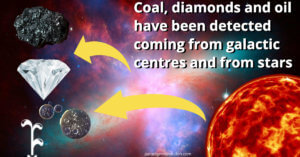
And the biggest oil field ever discovered exists in the far reaches of space. Not only that but coal has also been found coming out of stars.
It causing some people to find a way to mine the resources in space which is actually a rapidly growing industry. But why are oil and coal there in the first place?
Fossils in Space?
Oil and coal are supposed to be fossil fuels created from long-dead trees and marine life.
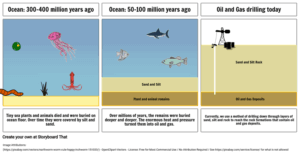
There are no trees or marine life on Titan or Mars on stars or outer space so what is going on?
Upwelling theory
A big clue came from Physicist, Thomas Gold who wrote in his book, The Deep Hot Biosphere that the pattern of distribution of oil and coal on Earth fits an upwelling origin – which means that oil and coal are coming up from the deep and not sinking down from the surface.
It really is an excellent book that exposes that many of our ideas about fossil fuels and how they are created just do not stack up to the evidence. Gold was not the first to propose this idea; Russian scientists did so too.
Oil from Black Holes
I am proposing that the reason we see hydrocarbons all over space is that they are being produced by the Black Hole Principle.
According to this theory, Mars, Titan and even the Earth are prolific in producing oil from their interior.
But for the theory to be correct, we need to spot hydrocarbons coming out of black holes.
And indeed we do see greasy molecules from galactic centres.
A radical new theory that fits the evidence
So you heard it first on Punk Science TV – Fossil fuels are not fossils but created by the interiors of black holes, stars, planets, moons and even comets – that’s why comets are covered in hydrocarbons.
If you want to know more about how the universe really works then follow me on Facebook or Youtube for more Punk Science TV
Further reading
Fossil fuels and black holes
Methane on Mars

by Dr Manjir Samanta-Laughton | Mar 25, 2020 | Punk Science, Science
Where did the Water of the Earth come from?
The Earth is almost covered with water, but it may surprise you that scientists are still debating as to how all this water got here in the first place. The general consensus is that water arrived originally on this planet via an impact collision with a comet or asteroid. Analysis of comets and asteroids in space have shown that the type of water they contain is not always an exact match.
The real answer is that we don’t know for sure the answer to this pretty basic question.
Finding the Solution
According to the Black Hole Principle, each and every celestial body from stars to planets to comets has the ability to create its own water from its centre. In this way, they follow the pattern laid out for everything from supermassive black holes to thunderstorms.
The Ocean beneath us
The Earth is no different. In 2013, I gave a keynote lecture at the Institute of Noetic Sciences in which I predicted that the water of the Earth is actually being produced by its interior. In just a few months, scientists announced to the world that an ‘ocean’ had been found deep below the Earth’s surface.
It is water bound up in rocks and crystals but nevertheless represents more water than exists on the Earth’s surface.
The Simple Pattern
Once you know The Black Hole Principle, you can easily make such predictions about the universe because you understand the simple underlying pattern throughout reality.
Therefore we have solved the questions of where Earth’s water has come from – it is being produced by the Earth itself.

